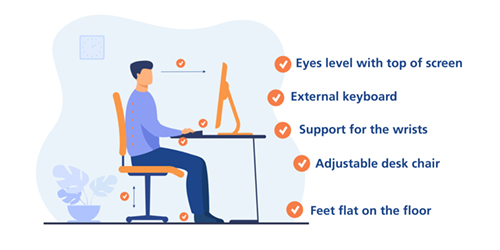From the physical therapy team at Mayfield’s Anderson Township office

Sitting at a desk looking at a computer screen, for long periods of time or even for a few minutes, can put pressure on your spine. With so many people working from home in recent years, the potential for back or neck pain is even greater. But even if you’re in a professional office setting with a high-quality desk chair, the strain on your spine still is there. From posture to the position of your computer screen, your setup is important to a healthy spine. Here are a few questions you should always ask yourself:
Where am I sitting?
If you’re at home and the couch or recliner looks really comfortable – don’t do it. Inevitably, those soft seats result in poor posture. Most workers are given a laptop to utilize at home, but it’s best to make it part of a well-constructed work station.
When I look straight ahead, what do I see?
Try sitting straight up with your head directly above your shoulders, and look forward. You should be looking at the top edge of your laptop screen or monitor. This will help you avoid excessive forward bending of the neck. Every inch that your head moves forward loads 10 pounds of additional force onto your cervical spine. Whatever screen you are using, you can use a laptop stand or riser to lift the screen to eye level, or even a stack of books.
Do I have the right equipment?
Office chairs are the key source of many problems. Ideally, your chair should have adjustable height and armrests, a headrest and lumbar support in the back. Many chairs, particularly older chairs at home, will not have any of these, so you should improvise. Find a chair of the right height with a cushioned seat, and maybe place a small pillow or rolled-up towel in the small of your back.
Once your screen is at the right height, you also should use an external keyboard and mouse to optimize posture. An external keyboard helps you avoid “shoulder shrugging” while typing, keeping your shoulders relaxed and arms in a neutral position.
What is touching the soles of my shoes?
If any doctor – or your drill-sergeant grandfather – tells you to sit with your feet flat on the floor, you should listen to them. Your hips and knees should be level sitting in the chair. Try not to lean back or lean forward.
Could I slip my cell phone under my wrists without making contact?
If so, you need more support under your wrists and arms. You can try something soft, like a wrist cushion support or even a folded hand towel, under your wrists to keep them in a neutral position, avoiding contact stressors or compression. Instead of a traditional mouse, you could try a vertical mouse or trackballs. This will help you avoid hand strain by reducing pronation, or twisting, of the forearm and encouraging a neutral wrist position. If you’re using a laptop stand, make sure it is tilted toward you, not flat on the desk. When you are typing, your shoulders should be relaxed and your arms able to rest on the surface without reaching forward.
How long has it been since I stood up?
If a standing desk is an option for you, take it. This will allow you to change positions throughout the day, reducing the strain on your spine. If not, try setting a timer on your phone every 30-60 minutes to remind you to take a break from sitting. Standing up and walking around for just a minute or two can loosen your muscles and reduce stiffness in your back. Some people even use a treadmill equipped with a laptop stand to mix up their sitting positions.
The folks at Merriam-Webster’s dictionary define ergonomics as “an applied science concerned with designing and arranging things people use so that the people and things interact most efficiently and safely.” Simply put, applying this science to your work environment can avoid unnecessary pain and stiffness. Protecting your spine while you work at a desk takes planning and effort, but it will be worth it. At Mayfield Physical Therapy, we are here to help.